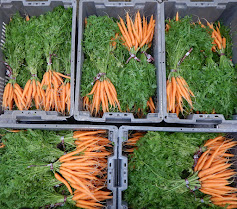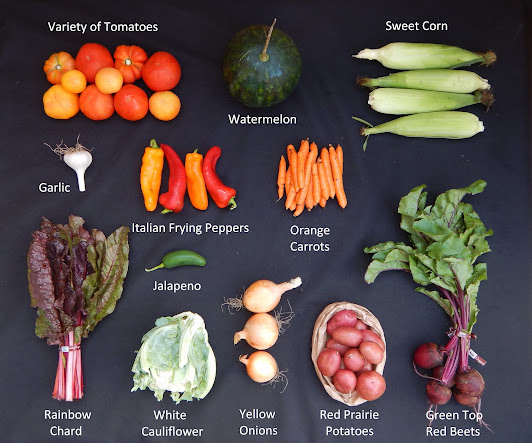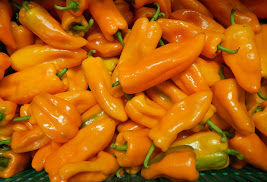Cooking With This Week's Box
Leeks:
Orange Carrots:
Asterix Potatoes:
Orange Italian Frying Peppers:
Mini Sweet Peppers:
White or Yellow Cauliflower or Broccoli Romanesco:
.jpg) |
| Photo from recipetineats.com |
Jalapeño Pepper:
Italian Garlic:
Red Carpet Onions:
Salad Mix or Baby Arugula:
Korean or Guajillo Peppers:
Orange Kuri Squash:
Winter Squash Turmeric Granola (See Below)
Baby White Turnips:
Hello!
This week we’re featuring winter squash! It’s that time of year, so pull out your favorite squash recipes and get ready! This week’s feature recipe is a little different. I like to make homemade granola and I like to include vegetables in every meal of the day, breakfast included. Thus, I was instantly intrigued by Amy Chaplin’s granola recipe for Winter Squash Granola with Turmeric (See Below). This is super simple to make and is not overly sweet. It’s delicious eaten as “cereal” with milk but is also a tasty topping to eat with yogurt, ice cream, or on top of baked fruit. I also included links to several of our favorite squash recipes from past years that are good ones to use with this week’s Kuri Squash.
This week we saw our first frost in the valley, but thankfully we were able to cover most of our pepper plants so we can continue to harvest! Check out this recipe for Everything Bagel Cream Cheese Stuffed Mini Peppers or use that single jalapeño pepper to make Cranberry Jalapeño Dip for something a little different. If you’re feeling like some comfort food, use your sweet peppers to make Roasted Pepper Potato Soup!
We have a different type of potato this week with the Asterix variety. This is a good variety to use in this recipe for Ultimate Baked French Fries or Baked Parmesan Garlic Potato Wedges. Serve these with a nice grilled burger topped with Caramelized Onion Jam with Balsamic Vinegar.
I hope you find some tasty ways to transition into fall this week. I wanted to update you on our sweet potato crop. The crew finished harvesting them last Saturday and the sweet potatoes are currently being “cured.” This is a 7-10 day process that helps to set their skins and develop the sugars. Hopefully they’ll be ready to start washing next week and if so, they’ll be in your box! Have a great week and I’ll see you next week!
-Chef Andrea
Vegetable Feature: Winter Squash
by Andrea Yoder
 |
| Sugar Dumpling Squash |
 |
| Orange Kuri |
.JPG) |
| Tetsukabuto Squash |
.JPG) |
| Autumn Frost Squash |
.JPG) |
| Butterkin Squash |
.JPG) |
| Heart of Gold Squash |
.JPG) |
| Jester Squash |
.JPG) |
| Black Futsu Pumpkin |
Winter Squash Turmeric Granola
.jpg) |
| Photo From amychaplin.com |
5 cups rolled oats
1 cup raw pumpkin seeds
1 cup raw unhulled sesame seeds
1 cup raw walnut pieces (or other nut of your choice)
2 tsp cinnamon
2 tsp ground ginger
1 tsp freshly grated nutmeg
1 tsp ground cardamom
½ tsp allspice
1 cup steamed or baked red kuri, kabocha or butternut squash
½ cup extra virgin coconut or olive oil
½ cup brown rice syrup or maple syrup
1 tsp ground turmeric
1 Tbsp vanilla extract
½ tsp salt
- Preheat oven to 325°F. Line 2 rimmed baking sheets with parchment paper and set aside.
- In a large bowl, combine oats, seeds, nuts, cinnamon, ginger, nutmeg, cardamom, and allspice. Set aside.
- In an upright blender, combine squash, oil, brown rice syrup or maple syrup, turmeric, vanilla and salt. Blend until completely smooth. Add to the dry ingredients and stir to combine.
- Divide between the two baking sheets and spread out evenly. Bake for 20 minutes, rotate trays and cook for another 15-20 minutes. Remove from oven and allow to cool before storing in jars. Granola will store well for 3-4 weeks.
Recipe adapted slightly from Amy Chaplin’s “Pumpkin Turmeric Granola” recipe found at amychaplin.com.

.jpg)
.jpg)

.jpg)
.jpg)
.jpg)

.JPG)


.jpg)
.jpg)
.jpg)




.jpg)
.jpg)
.jpg)

